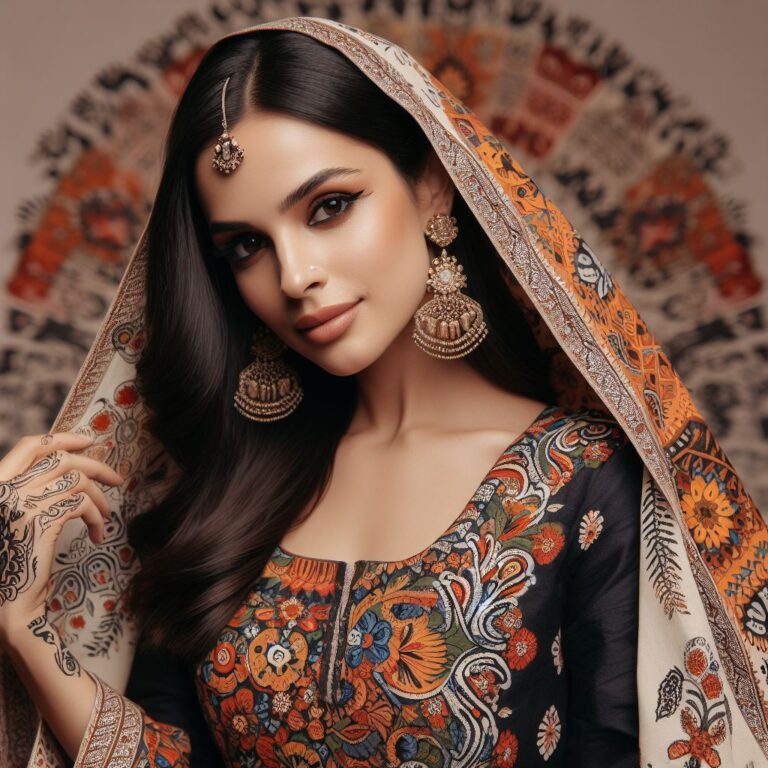Kalamkari, a traditional Indian art form, translates to “pen work” in Persian.
This exquisite art involves intricate hand-painting or block-printing on fabric, creating vibrant and detailed designs inspired by mythology, nature, and religious themes.
Originating in the Indian subcontinent, Kalamkari painting has a rich history that dates back more than 3000 years.
In this article, we explore the fascinating world of Kalamkari painting, its techniques, styles, and how to learn and appreciate this ancient craft.
Table of Contents
Historical Background
Kalamkari has two prominent styles: Srikalahasti and Machilipatnam. The former, originating from the temple town of Srikalahasti in Andhra Pradesh, focuses on mythological themes and intricate detailing.
The latter, from the coastal town of Machilipatnam, emphasizes bold, freehand drawing and vibrant colors.
Historically, Kalamkari was used for storytelling in temples and adorned the walls and ceilings of religious places.
Techniques and Materials
Kalamkari involves a painstaking process that includes several stages:
- Fabric Preparation: The fabric, usually cotton or silk, is treated with a mixture of milk and Myrobalan (a natural dye fixative) to make it mordant. This ensures the colors adhere properly.
- Outlining: The artists sketch the designs using a bamboo or date palm stick, which is sharpened to create a fine tip. This outlining gives the characteristic bold and intricate lines of Kalamkari.
- Filling Colors: Natural dyes derived from plants, minerals, and metals are used to fill the outlined designs. Artists often use tamarind twigs as brushes for finer detailing.
- Final Treatment: After the painting is complete, the fabric is washed to remove excess dye, giving the artwork its final vibrant appearance.
Styles and Themes
Kalamkari paintings feature a wide array of themes, including scenes from Hindu epics like Ramayana and Mahabharata, mythological figures, deities, animals, and nature. The intricate detailing and storytelling quality of these paintings make them a unique and cherished art form.
How to Learn Kalamkari Painting
Learning Kalamkari painting involves dedication, practice, and guidance from skilled artisans. Here are steps to help you get started:
- Find a Reputable Guru: Look for experienced Kalamkari artists or institutions offering workshops or classes. Learning from a skilled guru is invaluable in understanding the nuances of this art form.
- Understand the Basics: Familiarize yourself with the materials, tools, and techniques used in Kalamkari painting. Practice basic strokes and outlining to build your skills.
- Practice Regularly: Like any art form, regular practice is essential to mastering Kalamkari. Experiment with different designs and color combinations to enhance your creativity.
- Explore Online Resources: There are numerous online tutorials, videos, and forums where you can learn from experts and connect with fellow enthusiasts. These resources can provide valuable tips and inspiration.
- Attend Workshops and Exhibitions: Participate in workshops and visit exhibitions to observe the work of established Kalamkari artists. Interacting with professionals and art enthusiasts can broaden your understanding and appreciation of the craft.
Kalamkari painting stands as a testament to India’s rich artistic heritage, showcasing the skill and creativity of its craftsmen.
Learning this ancient art form not only allows you to express your creativity but also helps preserve a tradition that has been passed down through generations.
With dedication, patience, and the right guidance, anyone can embark on a fulfilling journey into the world of Kalamkari painting, creating beautiful and timeless artworks that captivate the senses and tell stories of the past.
FAQs about Kalamkari Painting
- What is Kalamkari Painting?
- Kalamkari is a traditional Indian art form that involves hand-painted or block-printed fabric. The name “Kalamkari” is derived from the Persian words “kalam” (pen) and “kari” (craftsmanship), reflecting the use of a pen-like tool for painting.
- Where did Kalamkari Painting originate?
- Kalamkari has its roots in ancient India, with historical evidence of its practice in regions such as Andhra Pradesh and Telangana. The art form has evolved over centuries and has two primary styles: Srikalahasti and Machilipatnam.
- What are the main techniques used in Kalamkari Painting?
- Kalamkari artists use two main techniques: “Srikalahasti” involves freehand drawing with a kalam (pen) and natural dyes, while “Machilipatnam” utilizes hand-carved blocks for printing and later hand-painting the details.
- What are the traditional themes depicted in Kalamkari Paintings?
- Traditional Kalamkari themes often include mythological and religious stories, scenes from epics like the Ramayana and Mahabharata, as well as depictions of flora and fauna. The art form is known for its intricate detailing and storytelling.
- What materials are used in Kalamkari Painting?
- Kalamkari artists use natural dyes derived from plants, minerals, and other organic sources. Cotton or silk fabrics serve as the canvas, and the pens or brushes used for painting are traditionally made from bamboo or date palm sticks.
- Is Kalamkari limited to fabric painting, or are there other applications?
- While fabric painting is the most common application of Kalamkari, the art form has expanded to include other items such as wall hangings, scrolls, panels, and even accessories like bags and scarves.
- How is Kalamkari different from other Indian painting styles?
- Kalamkari is distinct due to its use of natural dyes, storytelling themes, and the combination of freehand drawing and block printing. The use of a pen-like tool for intricate detailing is a unique feature of Kalamkari.
- Who practices Kalamkari Painting, and how is it passed down through generations?
- Kalamkari is traditionally practiced by skilled artisans, often organized in family-based workshops or communities. The art form is passed down through generations, with younger family members learning from experienced elders.
- Can Kalamkari paintings be purchased, and where can one find authentic pieces?
- Yes, Kalamkari paintings are available for purchase both in traditional markets in India and through online platforms. Authentic pieces can be found from reputable sources that collaborate with skilled Kalamkari artists or cooperatives.
- Is Kalamkari a dying art form, or is there a revival in contemporary times?
- While Kalamkari has faced challenges, there has been a revival and renewed interest in recent times. Contemporary artists and designers are incorporating Kalamkari techniques into modern fashion, home decor, and art, contributing to its continued relevance.


0 Comments